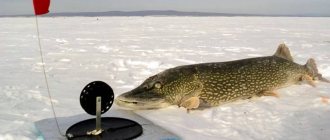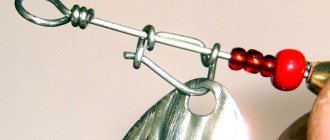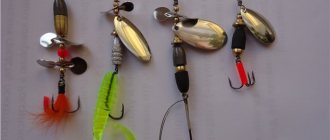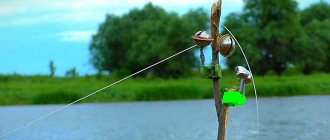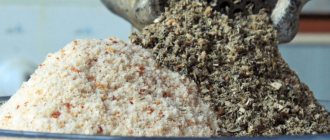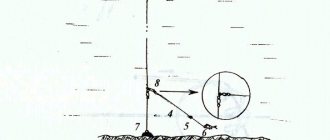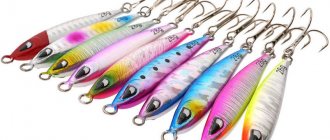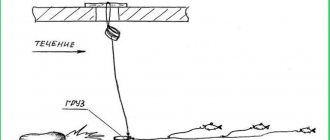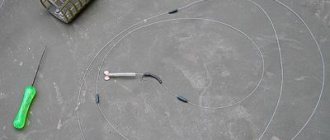Post fishing is a passive type of fishing. Nevertheless, she has many fans. The advantages of using the supply are that it is easy to manufacture and requires minimal costs. It’s easy to use, but always effective, so this type of fishing is suitable for both beginners and professionals.
The design allows you to catch pike with this tackle all year round - summer, spring, autumn and even winter. We will look at the differences between the equipment for ice fishing and the design for open water.
Principle of operation
The history of the supply began with the use of girders. These designs are very similar, but have several important differences. The fishermen shows the bite by raising a red flag. The catch does not signal a catch in any way. The fish is detected on its own, and the fisherman should know a few subtleties in order to detect the bite in time and pull out the catch. The supply is so easy to make that you can make a dozen or even more pieces in a few hours. In this case, a minimum of effort and money will be spent.
The supply works only with live bait. You can catch it in the river, or buy it in advance at a specialized store. Then the bait is unwound, the live bait is put on the tee and lowered into the reservoir. Fixing the tackle is done using a regular stick or other similar object. The stand is suitable for both winter and summer pike fishing.
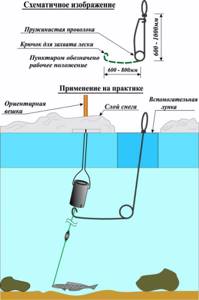
Fishing with a stand
Fishing for pike on a stand has several features and stages, including:
- The right choice of location. First of all, the fisherman must make sure that there is pike in the place he has chosen.
- Preparing fry for live bait. This could be perch, ruff, roach and other simple fish.
- The installation depth of the supply should vary from one to three meters. For fishing in reed beds, half depth is also suitable.
- For greater fishing productivity, it is better to install several stands at a short distance from one another. The optimal distance reaches fifteen meters. When placing several gears at a distance, regularly check them all for bites and catches.
- You can determine the bite by the shape of the fishing line. If it is stretched and located exactly horizontally, then there is no catch. If it is deformed, has bends or is located vertically, this means that the predator is already on the hook.

We have a detailed article on this topic. By the location of the bait after the bite, you can determine the size of the catch.
For example, a young pike, after being hooked, goes into the reeds or algae thickets. However, a large predator will drag the caught fry to the bottom of the reservoir. Keep track of the condition of the live bait and remove the catch immediately to attach a new fry. This will provide interesting and active fishing. However, if there are no bites for a long time, it is better to change the place for fishing.
We make the supply with our own hands
The process of making this gear is quite simple and anyone can handle it. To do this, you need to prepare all the materials in advance.
What you will need
- a piece of fishing line about 8 meters long with a cross-section of at least 0.5 mm;
- sinker weighing about 20 grams;
- a piece of small rubber hose, about 15 centimeters;
- a tee or a reliable double with a carbon leash;
- nylon thread.
Build process
After all the materials have been collected, you can proceed directly to collecting the supplies. This must be done carefully and carefully so that the device turns out to be of high quality and without flaws.
- Stepping back three centimeters from the edge of the rubber pipe, a through hole is made. Here the main fishing line and a nylon ring are attached, which will be attached to the spacer near the hole to stabilize the tackle.
- On the other side of the rubber hose, you need to make a neat cut of two centimeters. It is into this that the edge of the main line will be inserted.
- Depending on the depth of the reservoir where fishing will be done, a fishing line is wound around the tube. As a rule, 15 meters is enough here.
- The main line is threaded into the sinker and secured with special stoppers. A leash with hooks is attached to the free end.
- All protruding and uneven ends are cut off and the stand is ready for use; all that remains is to catch the bait and attach it to the hook.
There are a huge variety of different modifications of this gear. After all, every home craftsman prepares it for himself, taking into account the characteristics of the reservoirs where fishing is carried out. Some people use a rubber hose, while others prefer a bamboo cane.
Also, the quality of the hooks may vary. The most important thing when choosing them is to calculate so that they can withstand heavy loads. This happens due to the fact that supplies are often checked every few days. If the tackle or part of it is poorly executed, then the fish will most likely simply break loose and swim away.
Post fishing tactics
To catch the desired trophy on a stand, it is very important to know not only how to mount it yourself, but also how to properly fish with it. Experienced fishermen know the reservoirs and use their own method on each of them, which brings maximum efficiency.
First you need to choose the right fishing spot. Here you need to know the features of the reservoir: the state of the bottom, the channel, the presence of underwater obstacles, creeks. It is best to place the fish in snags, since this is where predatory fish are most active due to the large concentration of fry.
Next you need to catch and prepare live bait. Moreover, you need to keep it alive for as long as possible, since in this case the chances of a successful bite are much greater.
After the bait is placed on the hook, the tackle should be lowered into the water. As a rule, it is enough to lower the line by three meters. However, the bottom topography and the quality of the reservoir itself play a huge role here. So, in reeds and snags, the tackle is immersed only to half the depth.
To increase the chances of a rich catch, it is worth placing several stands at once with an interval of 15 meters from each other. If the tackle has changed its location, then it needs to be checked. If there is a catch, then remove it and replace the live bait with a new one.
You can fish with a fishing rod throughout the year, but it brings a particularly rich catch in October and November, when many predatory fish are most actively biting before the start of wintering. It is at this time that experienced fishermen come forward for predatory prey.
In summer, fishing with such gear is usually done from a boat. Experts recommend installing stands along the boundaries of reeds, thickets, in channels between rivers, and on rifts. Small fish most often accumulate in these places in search of food. And this is precisely what attracts a large number of predatory fish here that don’t mind hunting.
Installation locations
Pike feel safe in the area near the shore, where there are a lot of rhizomes and algae. In addition, in such places a lot of fry swim, which the predator feeds on. Therefore, such zones are productive for catching pike. For a fisherman, it is best to install the stand in the following places:
- In the coastal part, where there are a lot of reeds and grass. After standing near the reservoir for some time, you can notice how the pike repeatedly appears on the surface.
- In the area of a fallen tree or where there are a large number of snags.
- Channels where strong currents border on standing water are also one of the favorite habitats of pike.
- In spits with a sandy bottom, located lower than the islands, in island straits and similar areas near the coast.
However, it is difficult to fish in areas littered with cramps without breaking the gear. It will be easier if the supply has a fixed supply of fishing line. Thanks to this, the pike will not take the gear far into the snag and will not tangle it. It is also important to choose the right live bait. The best choice is bleak, which likes to float to the surface instead of sinking to the depths and tangling the line. Throw the supply not into a snag, but between two overgrown areas.
To prevent the pike from cutting the leash, you can attach the fishing line to several reeds located nearby near the shore. If you choose the right place for pike fishing, the bite should be noticeable after 15 minutes. Bycatch is sometimes large perch or pike perch.
Useful tips
Tips from experienced fishermen will help simplify burbot fishing:
- If you plan not just to set up the tent and leave, but to stay by the pond all night, you need to take a tent with you so that you can shelter from bad weather. The predator loves rain, snow, and strong winds, so it is better to go fishing in bad weather.
- You should definitely have a flashlight with you, or better yet several, because at night it can be difficult to see anything. In addition, the predator prefers days when there is no moon in the sky to illuminate the shore.
- It is advisable to build a fire near the fishing spot. Its light attracts burbot in the same way as the radiation from lanterns.
- It is sometimes difficult to get to the shore where fishing will take place by car. If there is no snow yet, it is recommended to take a cart with you so as not to carry gear on yourself. In winter, you can use a sled.
- It will be cold at the reservoir at night, you need to dress warmly, take a change of clothes with you just in case, hot tea and food.
- You must be extremely careful when going out on the ice. First make sure of its strength, especially during a prolonged thaw.
Summing up, we can conclude that the bait is one of the most effective tackles for burbot. It is used mainly in winter, when the predator is most active. However, application is possible at any other time of the year. In this case, the tackle is tied to a tree or fixed to a stick stuck in the ground.
You can sprinkle the stand with snow to hide it from strangers, remember the place and go home, coming to check it every few days. This gear can also be used by active fishing enthusiasts as an additional fishing method.
What is a burbot snitch, how to make it with your own hands and fishing techniques, read our article.
Additional gear
In addition to the supply itself, fishing with it requires some more gear and tools. One of the reasons for this is the characteristics of the predator. Pike has very sharp teeth. She also usually swallows the bait very deeply. For this reason, a fisherman may cut his hands when removing the hook from the inside of the fish.
To avoid this and other unpleasant situations, stock up and use the following devices:
- With a gapper you can easily open the mouth of a fish and fix it in this position. The device works as follows: the gapper is closed and placed in the pike's mouth (this is easy to do even if the mouth is closed). The device is then released and, thanks to a spring built inside, expands, leaving the predator's mouth open.
- Then you need to use an extractor or a medical clamp to remove the hook from the insides of the predator.
- To make it easier to remove large and active fish from a pond, you can use a landing net.
- To store caught predatory fish while you continue fishing, use a cukan or a rope on a wire.
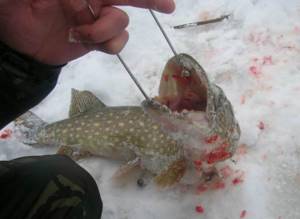
Using a yawner will protect your hands from injury
Bite and hook
Some fishermen do not know how to catch pike on a fishing rod in winter. The flags are raised, the bait is cut by the teeth - but there are no fish. Experienced zherlichniks can skip this paragraph. The toothy fish is passive in winter; it rarely swallows live bait right away. Most often, the predator grabs the fish across, after which it moves towards the ambush, to the side, or simply stands still (sometimes for several minutes). She simply holds the fish in her mouth, waiting until it stops fluttering. After which the predator turns the victim’s head towards its throat and swallows it. It is at this moment (or later) that you can hook.
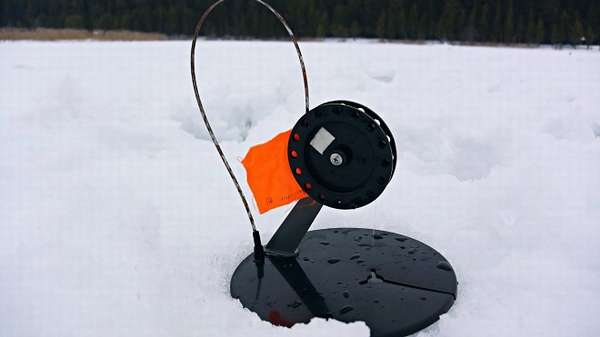
How to properly hook a pike onto a fishing rod in winter? Until this moment, the line should come freely from the reel of the girder. If there is resistance to the gear (the line supply is too short, the reel is frozen), the predator will spit out the prey. Therefore, when triggered, you need to quietly approach the gear and observe the unwinding. Usually the toothy one unwinds part of the reserve and stops to swallow the prey. When resuming unwinding, you need to wait a little and hook. Sometimes the pike does not stop or, on the contrary, stands still. In the first case, we hook when there is little line left on the reel, and in the second, a couple of minutes after the trigger (we let the fish swallow the bait). To properly catch pike with girders in winter, a certain skill and knowledge of the predator’s habits is required. This experience is acquired only on a pond during fishing.
In the process of playing, the toothy one can make several jerks. But in general, her behavior is much more passive than in the summer. The caught predator must be taken into the hole and hooked with a hook. You should not climb into its mouth with your bare hands - it is better to use a gaper, extractor or tongs to free it from the hook. A variety of bacteria live in the mouth of a predator; cuts caused by teeth do not heal for a long time.
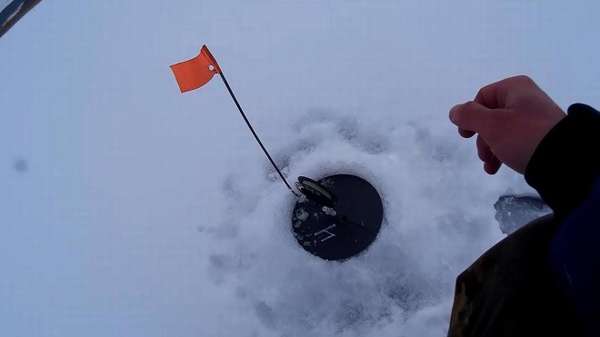
What kind of live bait is suitable for catching pike
Young pike feed on fry of carp and perch species. An adult has a more expanded diet, which may include fry of vendace, perch, roach, crucian carp, smelt, etc.

Choose live bait depending on the area in which you will be casting the bait. If this is a shore full of writhes and reeds, it is better to choose fry that like to swim on the surface - bleak, redfin, rudd. If the tackle is cast on a more or less flat and uncluttered bottom, it is better to give preference to fish that are distinguished by their vitality - perch, crucian carp.
Fishing Features
Usually, a pike, having caught a fry, does not swallow it immediately, but takes it to the side. If, while moving the catch, she feels that the fishing line is being pulled, she immediately lowers the fry and leaves.
To prevent such a reaction, you can use a tuck. This device is designed specifically so that the fish does not replace the tension of the fishing line and takes the bait to the depths completely without suspicion. But when she swallows it, you can safely pull out your catch and show your friends your new trophies.
Differences between winter and summer supplies
The positive side of using a stand in winter fishing is that it does not have surface equipment. When fishing with girders and other winter gear, some important elements remain above the water, which is why they freeze and reduce the functionality of the structure. However, the supply is not in danger of freezing. Since all equipment is under water during fishing.
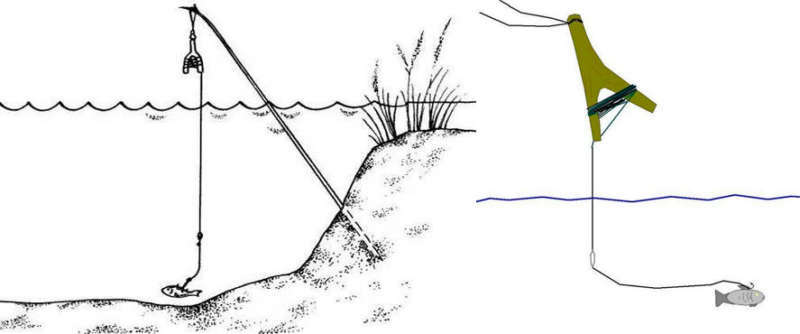
In winter, it is convenient to fix the stand over the hole. For example, to do this, it is enough to wrap the structure around a stick and place it horizontally, transverse to the hole. Securing summer tackle is a little more difficult.
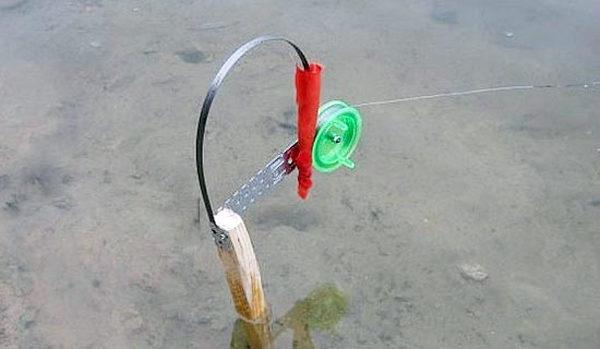
However, summer fishing for pike with a stand has its advantages. In warm weather, live bait can last much longer. This increases the likelihood of an active bite and saves live bait. In winter, replace the fry more often. In order for it to last as long as possible, it is better to avoid using gudgeon or bleak for such purposes, which are among a number of low-hardy fish.
Watch a video about summer fishing with baitfish:
Delivery from a container
Here is an example of making a supply from a plastic container with a screw-on lid.

Photo 1. Capsule.
We drill a hole in the capsule lid and attach a reliable cord; we tie its second end to a plastic tube or a simple stick.

Photo 2. Fastening the supply.
Then we connect the parts of the capsule and wind the fishing line onto a smooth cylinder and tie the equipment.
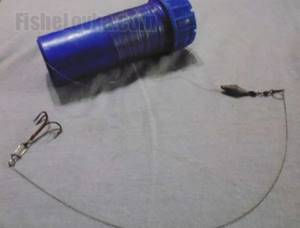
Photo 3. Equipped supply.
We put a rubber band on the cylinder, in which we clamp the loop of the equipment. After the bite, the supply of fishing line will slip out and give the fishing line to the predator. Now the supply can be equipped with live bait and lowered under the ice.
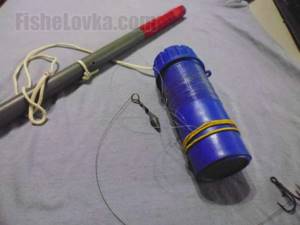
Photo 4. Wary tackle.
The assembled package takes up very little space.
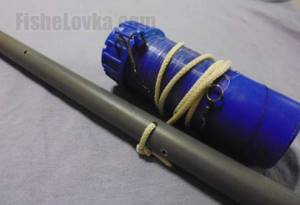
Photo 5. Delivery in transport version.
What other fish can you catch?
The postavushka is used not only as a tool for catching pikes. This tackle is also suitable for catching catfish, burbot, carp and pike perch.
- Winter fishing for pike perch is not easy. Most of the time he is at the depths of the reservoir, being in inaccessible holes. Therefore, you should throw the bait for pike perch early in the morning or late in the evening. The best place for fishing is in areas with a hard rocky bottom.
- Make a stand for catching catfish using a very strong fishing line or even a cord. The same applies to the choice of hooks - they must be powerful. With the same consideration, choose the method of tying knots on the fishing line in order to minimize its weakening.
A huge advantage of supplies is that thanks to their use, you can catch fish even in those reservoirs where there are few of them, spending a minimum of time. Just throw out a rig with hardy live bait and come back a couple of times a day to check the rig and pick up your catch. For greater effect, you can throw several supplies.
